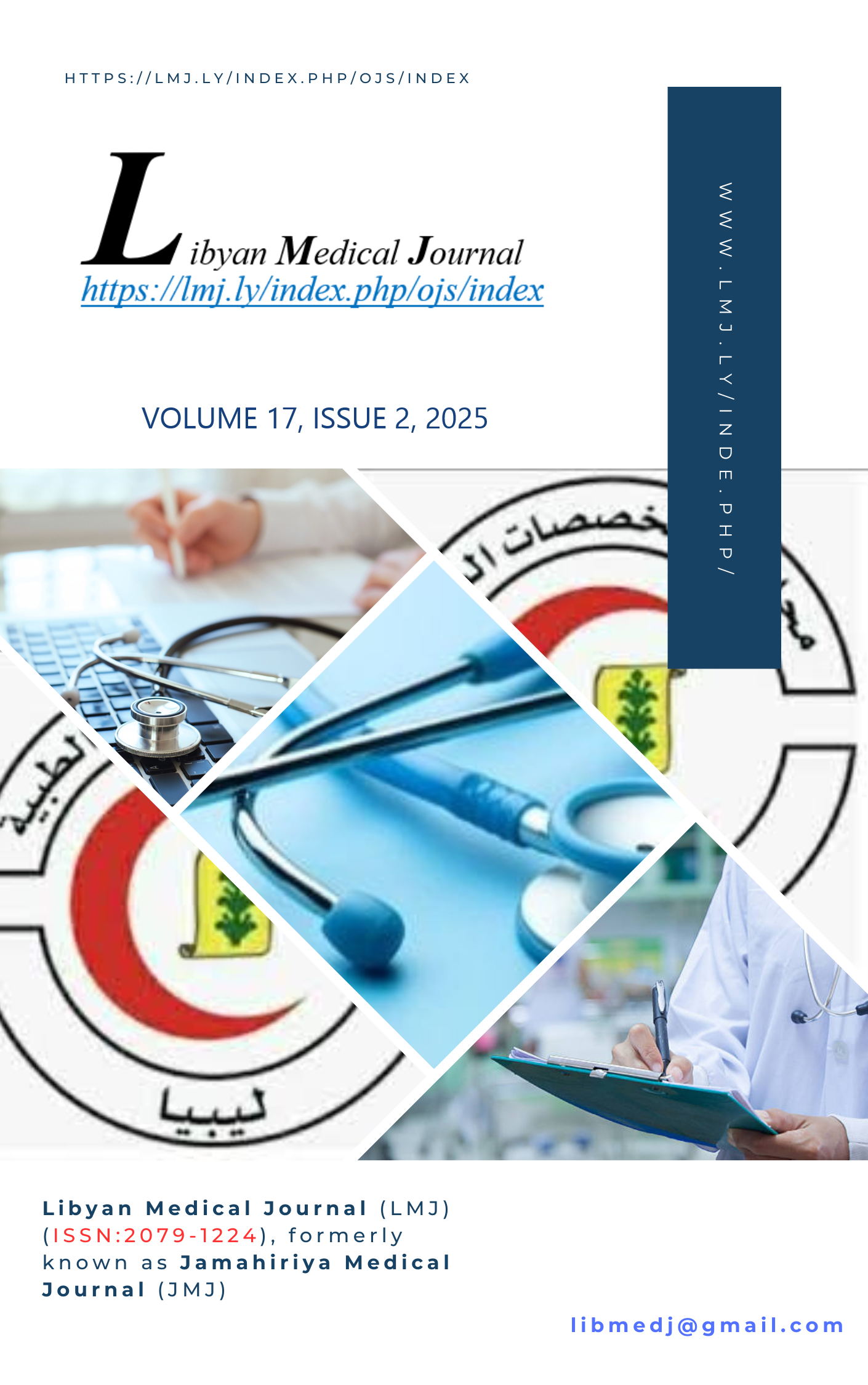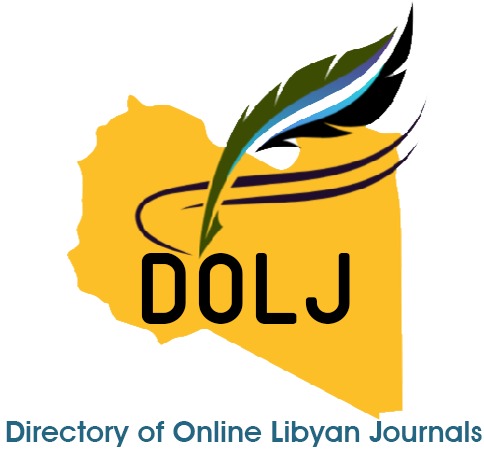Clinical and Bacteriological Characteristics of Cutaneous Leishmaniasis at the Outpatient Clinic, Tripoli Central Hospital, Libya
DOI:
https://doi.org/10.69667/lmj.2517224Keywords:
Cutaneous Leishmaniasis, Secondary Bacterial Infection, Antibiotic Susceptibility, Endemic DiseasesAbstract
Leishmaniasis is a common health problem worldwide, endemic in almost 90 countries, mostly tropical and subtropical regions in four continents. An increase in the number of cutaneous leishmaniasis (CL) cases has been reported over a wide area of the South and West of Tripoli. Since most of the CL cases referred for slit and smear and management if infected, the aim of our study was to determine the clinical aspects of CL, to isolate and identify bacteria responsible for secondary infection in the lesions, and to study the antibiotic susceptibility of the isolated organisms to commonly used antibacterial agents. A total of 450 patients with suspected CL attending the dermatology outpatient clinic in Tripoli Medical Center (TMC) and Tripoli Central Hospital (TCH) over a one-year period (June 2003 to June 2004) were examined. In each case, a detailed history and clinical examination were performed according to a protocol prepared for this study. The majority of patients were males (52%) with a male-to-female ratio of 1.1:1. Children, adolescents, and young adults—especially students and housewives—were the main age groups affected. Most patients were from the northwestern region and coastal area of Libya, and 96.7% of them were Libyans. Furunculoid and nodulo-ulcerating lesions (36.4% and 33.6%, respectively) were the main clinical types of CL reported, and most of the patients had either one or two lesions on exposed parts of the body. Samples from CL lesions for bacteriological examination were taken from 246 cases, and a positive culture was obtained in 37.4% of cases. Among the bacterial infections found, Staphylococcus aureus (S. aureus) was the most frequent isolate (62%) among children in the 0–10 years age group and young adults in the 21–30 years age group, while Staphylococcus epidermidis (S. epidermidis) was isolated less frequently (20.7%) in the 11–30 years age group. This study revealed that CL in Libya is endemic in certain areas and has a seasonal pattern, and S. aureus was the main isolate from CL lesions.
References
Klaus S, Frankenburg S. Cutaneous leishmaniasis in the Middle East. Clin Dermatol. 1999 Mar-Apr;17(2):137-41.
Roberts LJ, Handman E, Foote SJ. Science, medicine, and the future: Leishmaniasis. BMJ. 2000 Sep 30;321(7264):801-4.
Weina PJ, Neafie RC, Wortmann G, Polhemus M, Aronson NE. Old world leishmaniasis: an emerging infection among deployed US military and civilian workers. Clin Infect Dis. 2004 Dec 1;39(11):1674-80.
El-Buni AA, Jabeal I, Ben-Darif AT. Cutaneous leishmaniasis in the Libyan Arab Jamahiriya: a study of the Yafran area. East Mediterr Health J. 2000 Sep-Nov;6(5-6):884-7.
Edrissian GH, Mohammadi M, Kanani A, Afshar A, Hafezi R, Ghorbani M, Gharagozloo AR. Bacterial infections in suspected cutaneous leishmaniasis lesions. Bull World Health Organ. 1990;68(4):473-7.
Al-Fouzan AS, al Saleh QA, Najem NM, Rostom AI. Cutaneous leishmaniasis in Kuwait. Clinical experience with itraconazole. Int J Dermatol. 1991 Jul;30(7):519-21.
El-Dwebi H, El-Buni A, Refai A, Mashina H, Shafi M. Retrospective study on cutaneous leishmaniasis in Tripoli Central Hospital, Libya. Presented at: 4th Jamahiriya Medical Sciences Conference; 1998; Benghazi, Libya.
Hepburn NC, Tidman MJ, Hunter JA. Cutaneous leishmaniasis in British troops from Belize. Br J Dermatol. 1993 Jan;128(1):63-8.
El Buni AA, Edwebi H, Ben Darif AL. Prospective study among cutaneous leishmaniasis cases in Tripoli Central Hospital, Tripoli, Libya. Arch Inst Pasteur Tunis. 1997 Jan-Apr;74(1-2):3-4.
Al-Shammari SA, Khoja TA, Fehr A. Cutaneous leishmaniasis in Riyadh region: four-year study of the epidemiologic and clinical features. Int J Dermatol. 1992 Aug;31(8):565-7.
Bettini S, Maroli M, Gradoni L. Leishmaniasis in Tuscany (Italy): (IV) An analysis of all recorded human cases. Trans R Soc Trop Med Hyg. 1981;75(3):338-44.
Uzun S, Uslular C, Yücel A, Acar MA, Ozpoyraz M, Memişoğlu HR. Cutaneous leishmaniasis: evaluation of 3,074 cases in the Cukurova region of Turkey. Br J Dermatol. 1999 Feb;140(2):347-50.
Al-Gindan Y, Abdul-Aziz O, Kubba R. Cutaneous leishmaniasis in Al-Hassa, Saudi Arabia. Int J Dermatol. 1984 Apr;23(3):194-7.
Vera LA, Santos JB, Macêdo VO, de Magalhães AV, Ciuffo IA, Santos CG. Avaliação da influência da infecção bacteriana secundária na evolução da leishmaniose cutânea em Corte de Pedra, Bahia [Evaluation of secondary bacterial infection's influence on the course of cutaneous leishmaniasis in Corte de Pedra, Bahia]. Rev Soc Bras Med Trop. 2001 May-Jun;34(3):233-7.
Chahed MK, Ben Salah A, Louzir H, Marrakchi H, Zaatour A, Ftaïti A, Ben Chaabane B, Sidhom M, Dellagi K, Ben Ismail R. Efficacité du traitement de la leishmaniose cutanée zoonotique par le glucantime en intra-lésionnel, dans les conditions des soins de santé de base [Efficacy of intra-lesional glucantime in the treatment of zoonotic cutaneous leishmaniasis in basic health care conditions]. Arch Inst Pasteur Tunis. 1999 Jan-Apr;76(1-4):13-8.
Breyceson ADM, Hay RJ. Parasitic worms and protozoa. In: Rook A, Wilkinson DS, Ebling FJG, Champion RH, Burton JL, editors. Textbook of Dermatology. 6th ed. Oxford: Blackwell Scientific Publications; 1998. p. 1410–21.
Lapins J, Jarstrand C, Emtestam L. Coagulase-negative staphylococci are the most common bacteria found in cultures from the deep portions of hidradenitis suppurativa lesions, as obtained by carbon dioxide laser surgery. Br J Dermatol. 1999 Jan;140(1):90-5.











